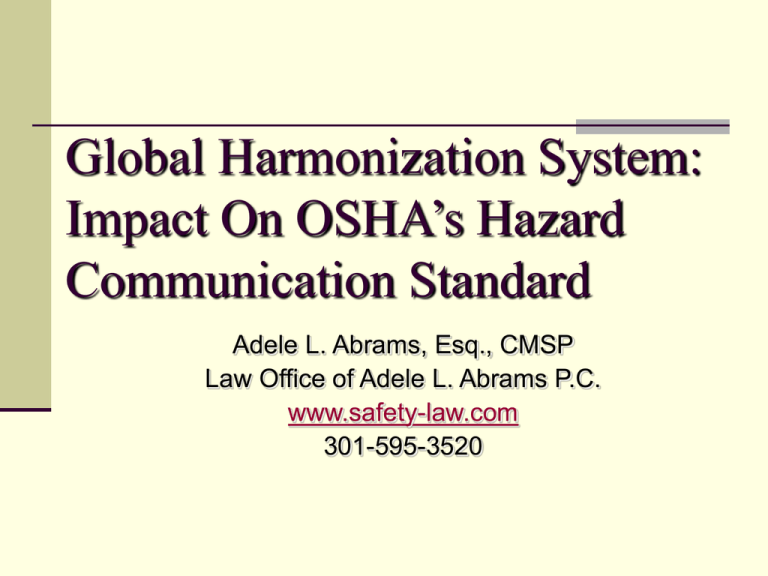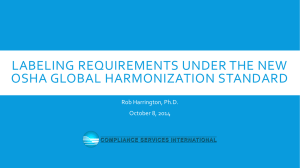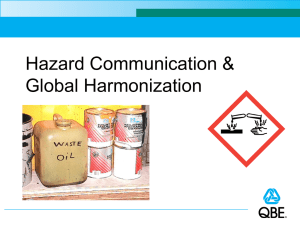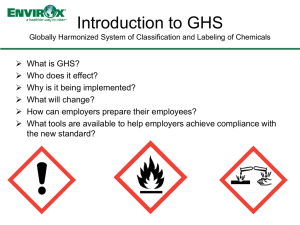Global Harmonization Impact On Hazard Communication
advertisement

Global Harmonization System: Impact On OSHA’s Hazard Communication Standard Adele L. Abrams, Esq., CMSP Law Office of Adele L. Abrams P.C. www.safety-law.com 301-595-3520 Overview OSHA has issued final rule to revise 29 CFR 1910.1200 (Hazard Communication Standard) Details released 3/20/12, final rule to appear in 3/26/12 Fed. Reg. Goal is to integrate components of the UN project’s Global Harmonization Standard (GHS) into HazCom Rule modifies MSDS requirements, labeling, classifications, and requires retraining of all employees. Significant opposition to standard from some business groups due to: Inclusion of “unclassified hazards”- altered in final rule, but legal challenges possible Some disputed economic impact estimates (costs of training, revised labels and MSDSs etc.) Overview Hazard classification: Provides specific criteria for classification of health and physical hazards, as well as classification of mixtures. Labels: Chemical manufacturers and importers will be required to provide a label that includes a harmonized signal word, pictogram, and hazard statement for each hazard class and category. Precautionary statements must also be provided. Safety Data Sheets: Will now have a specified 16section format. Information and training: The Final HCS will require that workers are trained within two years of the publication of the final rule to facilitate recognition and understanding of the new labels and safety data sheets. Global Harmonization Project Goal of establishing globally harmonized system for hazard communication established in 1992 at “Rio” Earth Summit. Mandate: “A globally harmonized hazard classification and compatible labelling system, including national safety data sheets and easily understandable symbols, should be available, if feasible, by the year 2000.” Global Harmonization Project Organization for Economic Cooperation and Development (OECD) coordinated the development of environmental and health hazard classification criteria. UN Committee of Experts on Transport of Dangerous Goods (UN COE) developed criteria for physical hazards (explosives, flammables, reactives). International Labour Organization (ILO) served as Secretariat for overall coordination. Global Harmonization Project Rationale for U.S. adoption of GHS: American companies are major importers of chemicals as well as exporters, and missing or incomplete information on chemicals we import may lead to reduced protections for workers and public. Large number of varying requirements around the world create potential barriers to trade in chemicals, particularly for small businesses. A harmonized and consistent approach has benefits both in terms of protection and trade. GHS General Principles The Globally Harmonized System (GHS) is not in itself a regulation or a model regulation. It is a framework from which competent authorities may select the appropriate harmonized classification & communication elements. Competent authorities will decide how to apply the various elements of the GHS within their systems based on their needs and the target audience. OSHA had to adopt through conventional rulemaking (governed by APA) before it can include components in mandatory HazCom standard MSHA has not yet placed HazCom revision (30 CFR Part 47) on its agenda The HazCom/GHS includes the following basic elements: harmonized criteria for classifying substances and mixtures according to their health, environmental and physical hazards; and harmonized hazard communication elements, including requirements for labeling and material safety data sheets. OSHA Rulemaking – Old Rule HazCom has been in effect for over 25 years; foundation for building a chemical health and safety program in workplace Addresses needs of employers/employees to obtain information about chemicals, and worker “right-to-know” about hazards Requires chemical manufacturers and importers to evaluate hazards and provide info to customers through labels, data sheets and worker training programs Also addresses trade secret protection Requires all chemicals to be evaluated and incorporates wide range of hazardous effects to be addressed. OSHA claims HazCom has resulted in 40% decrease in injuries/illnesses due to chemical exposures OSHA – Final Rule GHS specifies warnings and format Method of communication and information transmitted now varies – GHS makes more consistent GHS system is based on international negotiations and OSHA plans to learn from implementation experience of other nations New rule does NOT reduce level of protections afforded under original HazCom standard (29 CFR 1910.1200) OSHA – Final Rule Effective Dates: 12/1/13: All employees must be trained on new label elements and SDS format 6/1/15: Manufacturers and distributors must comply with all modified provisions except that distributors have until 12/1/15 to provide revised labels for all products shipped. 6/1/16: OSHA enforcement starts: Employers must update all labels and HazCom program, provide additional training for workers on newly identified physical or health hazards During transition period, employers can comply with old or new standard as far as labels and SDSs. OSHA – Final Rule GHS’ “Building block” approach allows competent authorities to choose from regulatory options in terms of which hazard classes and categories are adopted OSHA adopted the same basic BB as the EU … EXCEPT it will not address environmental hazards (outside jurisdiction) and it adds one more category of the flammable liquid class than EU did. System has 16 physical hazard classifications and 10 health hazard classifications, which determine label elements, pictograms, hazard statement, signal words and precautionary statement required. Sample Comments - Union AFL-CIO “strongly supported” proposal but wanted OSHA to expand exposure limits listed on SDSs to include ACGIH TLVs and NIOSH RELs, because OSHA PELs are outdated Union also wanted substance-specific standards to be included in SDSs (Sec. 15) to alert workers that there is a comprehensive standard on that chemical Union supported adding a definition of “unclassified hazards” to make sure that emergent hazards can be included within the scope of HazCom and to address combustible dust hazards. Sample Comment - Business US Chamber of Commerce had several meeting with OIRA opposing inclusion of “unclassified hazards” in the rule It has also challenged the purported cost savings as well as the economic impact analysis prepared by OSHA Urged switching the compliance deadlines (currently 2 years to train, 3 years to prepare new SDSs) so training can be done after SDSs are available. Another group with significant concerns is the American Chemistry Council, which also met with OIRA Sample Comments – ASSE ASSE endorsed the rule, but was “disappointed” that control banding was ignored in the development of the rule Urged OSHA to incorporate elements of control banding into HazCom to avoid need to revisit this later Challenged cost estimates for training time Suggested ACGIH TLVs should continue to be listed as well as NIOSH RELs, and suggested additional references to be considered by end users (AIHA also supports retention of TLVs and RELs) Advocated a quicker effective date for training but not for phsae in for the SDS and labeling requirements, and recommended significant compliance assistance be made available from OSHA What’s the Impact? Rule will impact over 5 million workplaces, and 43 million workers OSHA claims costs range from $38-$47 per covered entity for one-hour of training This did not add costs for developing new labels, SDSs etc. According to OSHA: Annualized savings for employers of between $585 mil and $798 mil Most of this through increased productivity for H&S managers and logistics personnel Expect 500+ workplace injuries and 43 fatalities to be prevented annually as a result of change Savings attributed to uniform SDSs and labels accounts for between $16 mil and $32.2 mil Safety Data Sheet Impact The performance orientation of HazCom’s MSDS will need to be changed. Use ANSI Z400.1 as template HazCom/GHS requires a 16 section MSDS format with specified sequence and minimum required contents. OSHA will not enforce elements 12-15 because deal with tranport, environmental issues outside jurisdiction The level of hazardous components can be given as ranges or concentrations - the values for component disclosure in mixtures vary by end point. Therefore, some changes will be needed for component disclosure. Appendix D – SDS Requirements 1.Identification of the substance or mixture and of the supplier 2.Hazards identification 3.Composition/information on ingredients Substance/Mixture 4.First aid measures 5.Firefighting measures 6.Accidental release measures 7.Handling and storage 8.Exposure controls/personal protection. 9.Physical and chemical properties 10.Stability and reactivity 11.Toxicological 12.Ecological information (non mandatory) 13.Disposal considerations (non mandatory) 14.Transport information (non mandatory) 15.Regulatory information (non mandatory) 16.Other information including information on preparation and revision of the SDS Hazard Determination Hazard determination/classification are self-classification processes – manufactures and importers must classify each chemical, determine appropriate hazard class and category based on evaluation of full range of available data/evidence No testing is required OSHA adopted “one study” rule for findings of hazards. Appendix A defines health and physical hazards Appendix B includes additional parameters to evaluate health hazard data Appendix F pertains to carcinogens A “floor” of chemicals to be considered hazardous is provided by reference to several existing lists of chemicals Added supplemental class: “Hazards not otherwise classified” and included coverage of combustible dust. Physical Hazards Hazard Class Explosives Flammable Gases Flammable Aerosols Oxidizing Gases Gases under Pressure Hazard Category Unstable Explosives Div 1.1 1 1 1 1 2 2 Div 1.2 Div 1.3 Div 1.4 Div 1.5 Div 1.6 3 4 Type C Type D Type E Type F Type G Type D Type E Type F Type G Compressed Gases Liquefied Gases Refrigerated Liquefied Gases Dissolved Gases Flammable Liquids Flammable Solids Self-Reactive Chemicals Pyrophoric Liquids Pyrophoric Solid Pyrophoric Gases Self-heating Chemicals Chemicals, which in contact with water, emit flammable gases Oxidizing Liquids Oxidizing Solids Organic Peroxides Corrosive to Metals Combustible Dusts 1 1 Type A 1 1 Single category 1 1 2 2 Type B 1 1 Type A 1 Single Category 2 2 Type B 2 2 3 3 3 Type C Health Hazards Hazard Class Acute Toxicity Hazard Category 1 2 3 4 1A 1B 1C 2 Serious Eye Damage/ Eye Irritation 1 2A 2B Respiratory or Skin Sensitization 1 Skin Corrosion/Irritation Germ Cell Mutagenicity 1A 1B 2 Carcinogenicity 1A 1B 2 Reproductive Toxicity 1A 1B 2 Lactation STOT – Single Exposure 1 2 1 2 3 STOT – Repeated Exposure Aspiration Simple Asphyxiants 1 Single Category 20 Current HCS versus Modified HCS HCS Corrosive definition "Corrosive:" A chemical that causes visible destruction of, or irreversible alterations in, living tissue by chemical action at the site of contact. For example, a chemical is considered to be corrosive if, when tested on the intact skin of albino rabbits by the method described by the U.S. Department of Transportation in appendix A to 49 CFR part 173, it destroys or changes irreversibly the structure of the tissue at the site of contact following an exposure period of four hours. This term shall not refer to action on inanimate surfaces. GHS definition of skin Corrosive Acute Toxicity Labeling For labeling, manufacturer/importer must include: Product identifier Signal word Hazard statement(s) Pictogram(s) Precautionary statement(s) Name, address, and telephone number of responsible party Once a chemical has been classified, the label preparer can obtain the relevant harmonized information from Appendix C OSHA is maintaining the flexibility for workplace signs and labels. Use of third party hazard rating systems such as the NFPA diamonds and HMIS is still a valid approach in the workplace Comparison of Labeling Requirements Old HazCom label requirements are totally performance -- oriented. The HazCom/GHS labeling requirements are specified: signal words, hazard statements, and pictograms. The use of pictograms is a significant change for US labeling. OSHA has retained NTP/OSHA/IARC carcinogen info OSHA has retained references to ACGIH TLVs Other Issues Will affect other standards (specific health standards) that have incorporated references to 1910.1200. Health hazard classification also includes specific listing for crystalline silica For combustible dust, may need to cross-reference NFPA 654 Listings on SDS could also lead to GDC enforcement where no PEL established for a chemical, as a recognized hazard, as well as enforcement over appropriate PPE/respiratory protection assessment (1910.132 and 1910.134) Expect OSHA to issue guidance within 6 mo. – many letters of interpretation are sure to follow! HCS Pictograms and Hazards Health Hazard Carcinogen Mutagenicity Reproductive Toxicity Respiratory Sensitizer Target Organ Toxicity Aspiration Toxicity Gas Cylinder Gases under Pressure Flame over Circle Flame Flammables Pyrophorics Self-Heating Emits Flammable Gas Self-Reactives Organic Peroxides Corrosion Skin Corrosion/ burns Eye Damage Corrosive to Metals Environment Exclamation Mark Irritant (skin and eye) Skin Sensitizer Acute Toxicity (harmful) Narcotic Effects Respiratory Tract Irritant Hazardous to Ozone Layer (Non Mandatory) Exploding Bomb Explosives Self-Reactives Organic Peroxides Skull and Crossbones (Non Mandatory) Oxidizers Aquatic Toxicity Acute Toxicity (fatal or toxic) GHS Sample Label – HAZARDS (Liquid): flammable liquid, flash point = 120°F; oral LD50 = 275 mg/kg Danger! Toxic if swallowed Flammable liquid and vapor Contains: XYZ Do not taste or swallow. Get medical attention. Do not take internally. Wash thoroughly after handling. Keep away from heat, sparks and flame. Keep container closed. Use only with adequate ventilation. FIRST AID If swallowed, induce vomiting immediately, as directed by medical personnel. Never give anything by mouth to an unconscious person. See Material Safety Data Sheet for further details regarding safe use of this product. Company name, Address, Phone number GHS Sample Label – Suspected Carcinogen (inhalation) My Product Warning! Cause Skin And Eye Irritation Suspected of causing cancer by inhalation Contains: XYZ Do not breathe vapors or mist. Use only with adequate ventilation. Avoid contact with eyes, skin and clothing. Wash thoroughly after handling FIRST AID EYES: Immediately flush eyes with plenty of water for at least 15 minutes. Get medical attention. SKIN: In case of contact, immediately flush skin with plenty of water. Remove contaminated clothing and shoes. Wash clothing before reuse. Get medical attention if irritation develops and persists. Company name, Address, Phone number HAZARDS (Liquid): moderate skin and eye irritant, possible cancer hazard by inhalation HazCom/GHS - Training Training users of hazard information is integral part of hazard communication. Systems should identify appropriate education and training for GHS target audiences who must interpret label and/or SDS information and take action in response to chemical hazards. Training should address: workers, emergency responders, and those involved with preparation of labels, SDS and HazCom strategies as part of risk management systems. Systems should also educate consumers in interpreting label information on products they use. HazCom/GHS Summary Level of protection offered to workers, consumers, general public and environment will not be reduced by GHS Involvement of concerned organizations of employers, workers, consumers and other relevant groups is essential Validated data already generated for classification of chemicals under existing systems should be accepted when reclassifying the chemicals under Haz/Com/GHS The new harmonized system may require adaptation of existing methods for testing. GHS and Control Banding GHS establishes an international system of classification and labeling that can be used in control banding. Control Banding provides an additional impetus for implementation of the GHS as a practical use of the information to control exposures. GHS adoption does not mean that control banding must be implemented, but . . . US/EU have proposed a pilot project related to the GHS and control banding, based on 2 high production volume chemicals. Information on project available at http://www.useuosh.org/ Conclusion Training of workers can begin immediately As new products are ordered, make sure to keep SDSs in new formats Companies that manufacture products will have to conform to both employer and manufacturer provisions of revised HazCom rule Litigation is possible over inclusion of “hazards not otherwise classified,” and combustible dust … could delay effective dates but best to prepare for dates listed. Conclusion Overall benefits of globally harmonized system: Promotes safer transportation, handling and use of chemicals; Improves understanding of hazards; Increases compliance and reduces costs for companies involved in international activities; Helps protect workers, consumers and potential exposed populations around the globe. Bottom Line: A new OSHA HazCom standard is inevitable . . . Plan ahead! QUESTIONS ? Contact Adele L. Abrams, Esq., CMSP at 301-595-3520 or write to: safetylawyer@aol.com







